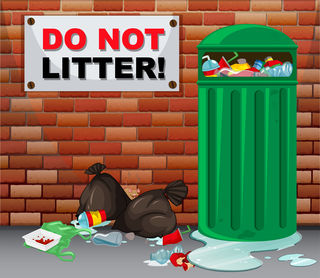
Environment
The Petrified Wood Principle
A paradox: Normalizing the behavior you wish to eradicate.
Posted September 26, 2019 Reviewed by Kaja Perina

Humans are social animals. We are strongly influenced by those around us. We adapt to what we perceive as normal behavior in an environment – the social norms. And this is especially important to our behavior in public spaces.
Imagine that you are in a national park in Arizona – the Petrified Forest National Park, to be precise. But this park looks more like the surface of Mars than a forest because the trees are no longer standing.
Approximately 218 million years ago, these plateaus and lowlands contained a great river system, forested by conifers, tree ferns, and gingkos. When the trees died they floated downstream, collected in logjams, and were eventually buried under earth and volcanic ash, becoming petrified. Today, this barren landscape is covered with formations of brilliantly colored minerals, preserved in the form of logs and stumps.
So imagine your walk through these so-called forests: Jasper, Crystal, Black, Blue, and most spectacular, Rainbow. There are so few people around, and so many petrified wood chips, and you start to wonder if it would be so terrible if you took one of these little rainbow gems home with you. But then you see a sign:
“Your heritage is being vandalized every day by theft losses of petrified wood of fourteen tons a year, mostly a small piece at a time.”
Would this make you less likely to take the wood chip?
Unfortunately not, according to Robert Cialdini of Arizona State University and his colleagues. In fact, it may even make you more likely to steal. This sign delivers logical statistics about a social problem: lots of wood chips are being stolen. But it also sends another very powerful message: everybody’s doing it! The sign assumes we are rational creatures who follow directions and make careful, information-based decisions. The problem is, we aren’t and we don’t.
Cialdini and his team spent five weeks scurrying around this Martian landscape placing different signs in the different colored forests, to test visitors’ reactions. When the sign simply read, “Please don’t remove the petrified wood chips," less than two percent of the wood chips were stolen. But when signs read, “Many past visitors have removed the petrified wood from the park, changing the state of the petrified forest," eight percent were taken – a four-fold increase.
The first sign delivers what is called an injunctive norm. It tells us what the rules are, how we should behave. But just like when we’re told we should stop smoking, eat vegetables, or abide by the speed limit, we often do not do what we should do.

The second sign communicates what’s normal in terms of what people are actually doing, which is called a descriptive norm. Let’s call them should norms and do norms. Do norms are very powerful. But unfortunately, the second sign makes it sound quite normal to steal a wood chip. It might as well say, “Get yours before it’s too late!” It normalizes the very behavior it is trying to prevent.
From simple health goals to the pressing need to reduce carbon footprints, the Petrified Wood Principal is critical to consider in any campaign or communication aimed at changing behavior.
Organizations typically come to me with a behavioral outcome they’re hoping to achieve as well as a desire to design for well being — they want people to be more careful crossing streets, print less, or share space respectfully with their coworkers. The Petrified Wood Principle is an essential tool for designing workspaces, streets, or communication campaigns inspiring people to behave conscientiously though the power of communal affiliation.
The strangest turn in the Petrified Forest story is that park authorities ultimately decided not to change their signage! Based on interviews with park visitors who said the original signs would deter them from stealing, administrators decided to keep the counter-productive signs — despite Cialdini’s compelling evidence.
We have a strong desire to believe we can control behavior through logic and information, even when we’re shown we can’t.
This post is adapted from my book, The Shaping of Us: How Everyday Spaces Structure Our Lives, Behavior, and Well-Being, published by Trinity University Press in 2019.
References
Cialdini, R.B., Demaine, L.J., Sagarin, B.J., Barrett, D.W., Rhoads, K., & Winter, P. (2006). Managing social norms for persuasive impact. Social Influence, 1(1), 3-15.
Goldstein, N. J., Cialdini, R. B., & Griskevicius, V. (2008). A Room with a viewpoint: Using social norms to motivate environmental conservation in hotels. Journal of Consumer Research, 35(3), 472-482.

